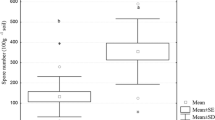Abstract
Knowledge of physical, chemical and biological soil characteristics influencing plant response to inoculation with arbuscular mycorrhizal (AM) fungi would help to distinguish soils where inoculation could be profitable. The relationship between leek (Allium porrum L.) response to mycorrhizal inoculation with Glomus intraradices Schenck & Smith or G. versiforme (Karsten) Berch and soil texture, bulk density, particle density, porosity, pH, organic matter content, available P, K, Ca, Mg, Fe, Zn, Cu, and Mn, soil structure, soil mycorrhizal potential (SM), preceding crop mycorrhizal potential, composition of indigenous mycorrhizal fungal communities, and the abundance of spores of different species, was studied in 81 agricultural soils using Principal Component Analysis and regression analysis. The nature of the indigenous AM fungi population was an important determinant of leek response to inoculation (RTI). In soils with more than 200 μg available P g–1, SM potential accounted for over 27% of RTI with G. intraradices and G. versiforme, RTI being high in soils with low SM potential. In low P soils, however, a positive relation between the abundance of water stable soil aggregates in the 0.5–2 mm diameter range and RTI was most important. Low soil Zn and high porosity, abundant total mycorrhizal spore as well as scarcity of spores of G. aggregatum and of the group G. etunicatum-rubiforme were also associated to high RTI. The influence of water stable aggregation of soil on RTI was modulated by soil P levels. Abundance of soil aggregates was positively related to RTI at low soil P levels, but negatively related to RTI at high P levels. Different relationships were found between soil variables and spore abundance of different AM fungi species. Some AM species appear to have as yet undefined similarities or complementarities at the biological or ecological levels.
Similar content being viewed by others
Author information
Authors and Affiliations
Additional information
Accepted: 23 July 1997
Rights and permissions
About this article
Cite this article
Hamel, C., Dalpé, Y., Furlan, V. et al. Indigenous populations of arbuscular mycorrhizal fungi and soil aggregate stability are major determinants of leek (Allium porrum L.) response to inoculation with Glomus intraradices Schenck & Smith or Glomus versiforme (Karsten) Berch. Mycorrhiza 7, 187–196 (1997). https://doi.org/10.1007/s005720050180
Issue Date:
DOI: https://doi.org/10.1007/s005720050180




